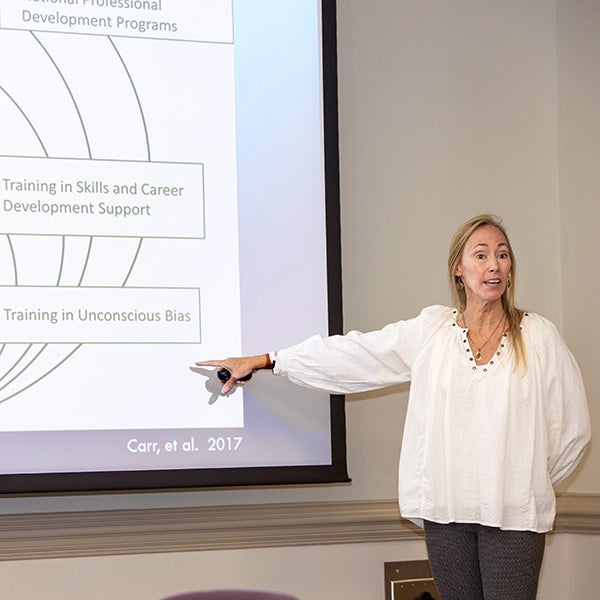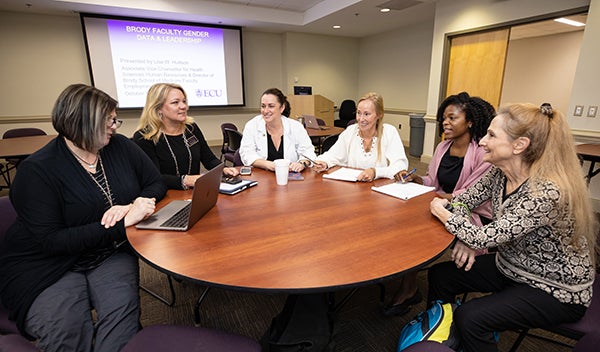Brody scientist’s data-driven approach to explaining gender bias gets national attention
Often discussed, but less frequently understood, gender bias is being assessed in a new way thanks to a microbiologist from ECU’s Brody School of Medicine. Working to help scientists across the country better understand the extent of gender bias and its implications, Dr. Rachel Roper communicates through a language that they can’t ignore: data.
Roper, an associate professor of microbiology and immunology who has also served as chair of the Chancellor’s Committee on the Status of Women and is chair of the Brody Women Faculty Committee, has been a first-hand witness to some of the additional difficulties that women face as they work to advance in their careers in academia and science. Although it’s not difficult to find stories that exemplify these types of challenges, Roper began to consider that hearing these sorts of anecdotes is not enough to convince scientists that gender bias is a pervasive problem, even in areas where a lot is already being done to combat it.
“They tell us that we need to go to equity and diversity training, but why would anybody go to that, because we don’t believe it’s a problem?” Roper said. “We have to actually believe there’s a problem before trying to deal with it and solve it.”

Dr. Rachel Roper, an associate professor of microbiology and immunology at ECU’s Brody School of Medicine, is working to help scientists across the country better understand the extent of gender bias and its implications. (Photos by Rhett Butler)
Roper began keeping a list of references of studies that show gender bias in science, medicine and academia, and compiled the data that she found into a manuscript titled “Does Gender Bias Still Affect Women in Science?” The manuscript cites only recent publications since bias and gender issues evolve, Roper said. She also chose well-designed studies that were statistically significant. The manuscript was published in the American Society for Microbiology’s scientific journal, “Microbiology and Molecular Biology Reviews,” in July.
Since she began compiling the data, Roper has been invited to give seminars and lead discussions on the topic of gender bias at ECU and recently at several prestigious scientific organizations around the country, including the National Institutes of Health, the American Society for Virology and at the American Society for Microbiology’s annual meeting.
“Dr. Roper provided the audience with an outstanding summary of the evidence for bias across all career stages of the biomedical research workforce, from trainees to faculty,” said Dr. Hannah Valantine, NIH Chief Officer for Scientific Workforce Diversity and Senior Investigator, National Heart, Lung, and Blood Institute (NHLBI) of Roper’s NIH presentation in December.
“Her approach of presenting the scientific evidence is most compelling for an audience of scientists who often are unaware of the extensive literature about this issue. Her presentation is also consistent with current thinking in the field of bias research which indicates that awareness is the first step towards mitigating the effects of bias in decisions making.
“Dr. Roper’s presentation nicely complements the tools that my office provides for helping search committees diversify their applicant pools, employ best practices in the conduct of searches for tenure track and tenured investigators, and for leadership positions. Importantly, education on implicit bias and ways to mitigate its effects are central to NIH’s efforts to create an institutional culture of equity and mentorship.
“Provost Mitchelson (who is now interim chancellor) had me come out and give a talk to the deans and directors on some of the bias data a couple of years ago, and afterwards, one of the deans came up to me and said ‘finally, someone showed some data,’” Roper said. “Scientists don’t believe things unless we see the data. We hear complaining about bias, or claiming that there is bias, but that doesn’t mean there is bias. These studies prove there is bias today in scientists and faculty, so that’s really important.”
Evidence of bias
Among the studies cited in her work is a randomized, double-blind experiment published in the journal “Proceedings of the National Academy of Sciences,” in which researchers changed the first names on identical resumes to a common male or female name and asked faculty members to rate the students for a lab position.
“Faculty are supposed to be educated, open-minded and have equity and diversity training — so this should be the least biased group that you look at, right?” Roper said. “Their conclusion was that the faculty participants rated the male applicant as significantly more competent and hirable than the identical female applicant. They considered the woman significantly less competent, at a P of less than .001 — so it was highly, highly statistically significant.
“The woman’s hirability was rated way less, and mentoring — how much mentoring would you give this person — a lot less mentoring was considered to be given to the female student than the male. The females were (rated) less competent, but more likeable on these identical resumes. So, people were projecting their own expectation of women onto these resumes.”

Roper, third from the right, has served as chair of the Chancellor’s Committee on the Status of Women and is chair of the Brody Women Faculty Committee, shown above.
The studies within Roper’s manuscript show that gender bias is not only a problem among older generations or men, but that young people and women also have biases related to gender that can impact their decisions.
One study asked Master of Business Administration students to hire a candidate for a mathematics job. They were provided the candidate’s typical information along with the candidate’s gender and math score.
“Both male and female subjects were more likely to hire the man than the woman at a P less than .003, so a huge statistical significance there, even when the males’ math scores were lower than the females, and they were being hired for math positions,” Roper said.
One study cited shows that students have higher expectations of female instructors at the university level than they have of male instructors. Another provided evidence that in publishing research, a woman is perceived to have done less work if she has published with a man than if she published with another woman.
“This is a big deal for hiring, promotion, tenure,” Roper said, “and in most of the settings, both men and women are biased against women because we’re all raised in the same society.”
-by Natalie Sayewich, University Communications